Welcome to your ultimate guide to all of the UNESCO World Heritage Sites in Greece! From the awe-inspiring Parthenon in Athens, one of the best-preserved monuments of classical antiquity, to the historical depth of Vergina, the resting place of the father of Alexander the Great, this guide covers the locations and significance of each heritage site in Greece.
Discover why these sites, including the sacred Temple of Athena Nike and the spiritual legacy of John of Jerusalem, are must-visit landmarks. Greece, home to many religious and secular buildings of immense historical importance, offers a unique journey through time.
Whether you’re drawn to important religious sites or the architectural marvels of ancient civilizations, our guide explains why each UNESCO World Heritage Site in Greece is an essential part of the country’s cultural and historical fabric.
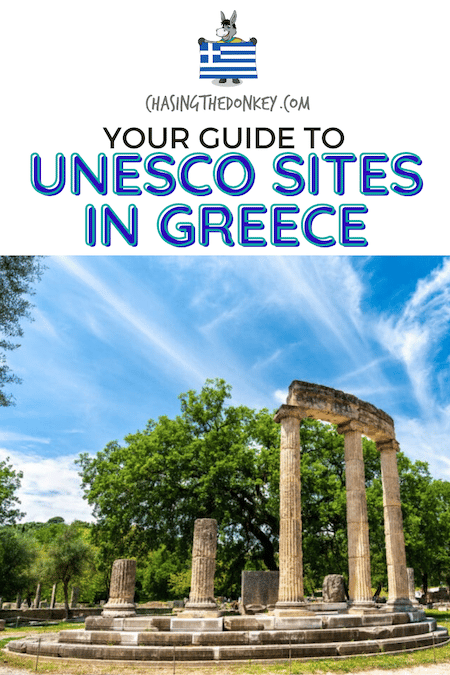
UNESCO sites are some of Earth’s most beautiful and culturally significant places. If you’re looking for a list of must-see destinations that highlight the first bases for the spread of Christianity, look no further than Greece! This Mediterranean country is home to 19 UNESCO World Heritage Sites, including ancient ruins, monasteries, and seaside villages.
Here are a few of the UNESCO sites in Greece that you must add to your travel bucket list!
Skip Ahead To My Advice Here!
1. Temple Of Apollo Epicurius At Bassae

The Temple of Apollo Epicurius at Bassae is one of the most important UNESCO Greece sites. This temple is notable for its unique architecture, combining elements of the Doric and Ionic orders.
The temple was built in the 5th century B.C. and is considered one of the best-preserved examples of Ancient Greek architecture. The site also includes a well-preserved theater for musical performances and other events. The Temple of Apollo Epicurius at Bassae is an essential site for anyone interested in the history and culture of Greece.
2. Archaeological Site of Olympia
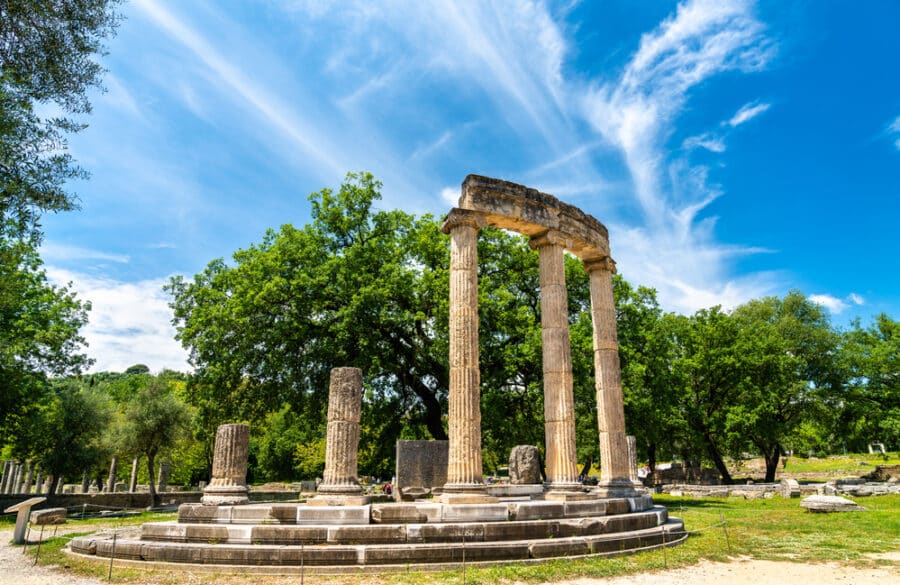
The Archaeological Site of Olympia is another must-see UNESCO site in Greece. This site is home to the remains of several important buildings, including the Temple of Zeus, the Philippion, and the Palaestra. These ruins offer insight into the religious and cultural life of the Ancient Greeks.
The Archaeological Site of Olympia also includes a museum, which houses an extensive collection of artifacts from the site. This historical site is a must-visit for anyone interested in Greek history and culture.
3. Acropolis Of Athens

The Acropolis in Athens is an iconic symbol of Greece, and it’s easy to see why: it has been the site of significant political and religious events since ancient times.
The Athens Acropolis is home to several important monuments, including the Parthenon and the Erechtheion. These ruins are some of the best-preserved examples of Ancient Greek architecture. The Acropolis is an essential site for anyone interested in the history and culture of Greece.
4. Archaeological Site Of Delphi
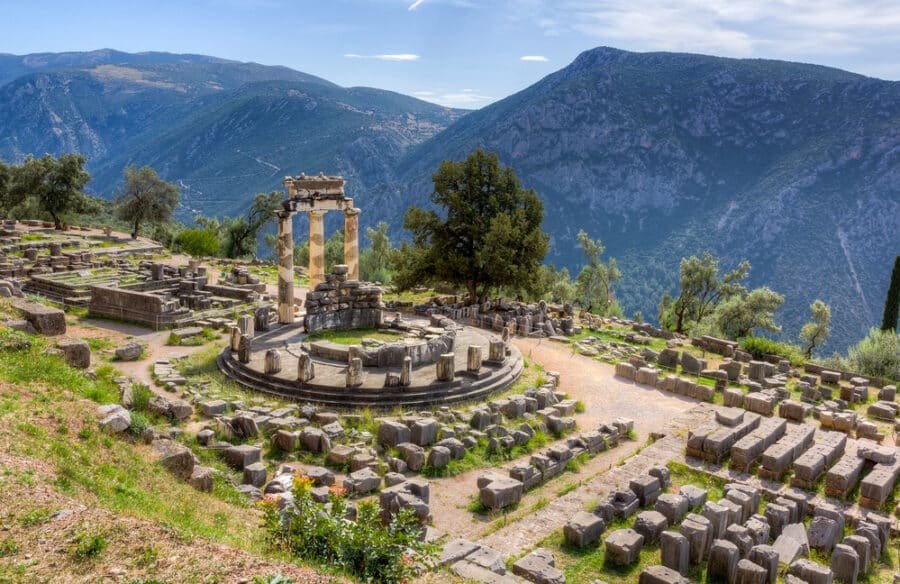
The Delphi Archaeological Site is another must-see UNESCO site in Greece. This site, recognized under the World Heritage Convention, has many ruins, including the Temple of Apollo, the Stadium, and the Theatre of Delphi.
These ruins give visitors a glimpse into the religious and cultural life of Ancient Greece. The Archaeological Site of Delphi also includes an impressive museum, which houses a collection of artifacts from the site. The Archaeological Site of Delphi is an essential destination for anyone interested in Greek history and culture.
5. Medieval City Of Rhodes

The medieval city of Rhodes is a UNESCO site in Greece located on the island of Rhodes in Greece. The city was founded in the 7th century B.C. and was an important trading center in the Mediterranean.
The Ottoman Empire conquered the city in 1522, and it was converted into a military fortress. The city has historical landmarks, including the Palace of the Grand Master of the Knights Hospitaller, the Street of the Knights, and the Cathedral of Saint John. In addition to its architectural importance, the city also boasts a Mediterranean climate, making it a perfect place to visit year-round.
6. Meteora
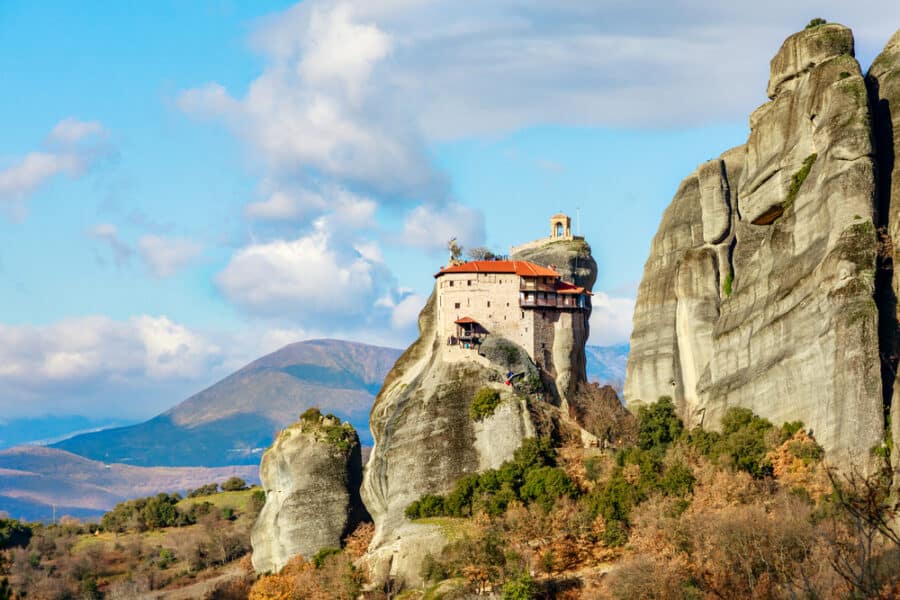
Meteora is a stunning site located in central Greece. This area is home to several monasteries perched atop massive sandstone cliffs.
The monasteries were built in the 14th century and continue to be active today. Meteora is renowned for its remarkable architecture and views of the beautiful landscape. It’s an essential UNESCO Greece site for anyone interested in the cultural and religious history of Greece.
7. Paleochristian And Byzantine Monuments Of Thessaloniki
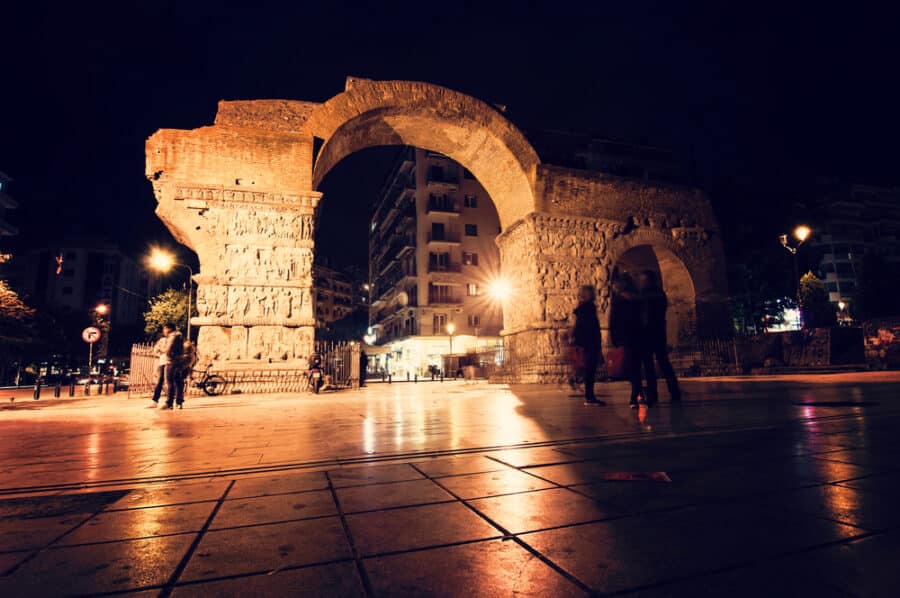
The Paleochristian and Byzantine Monuments of Thessaloniki are a UNESCO World Heritage Site located in the city of Thessaloniki in Macedonia. This historic site includes over 20 different churches and cathedrals, many dating back to the 4th and 5th centuries.
Highlights include the Church of St. Demetrios, the Rotunda of Galerius, and the Porta Gallio. These well-preserved buildings provide a fascinating glimpse into early Christian history and architecture.
Brands We Use And Trust
8. Sanctuary Of Asklepios At Epidaurus
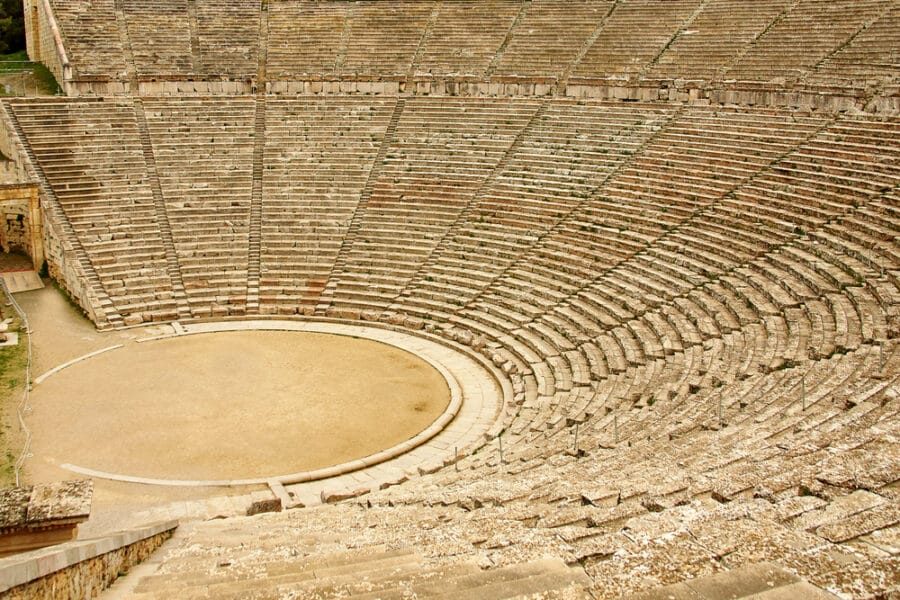
The Sanctuary of Asklepios at Epidaurus is an important archaeological site in the Peloponnese region of Greece.
This sanctuary was built to honor Asklepios, the Greek god of healing. It includes several well-preserved ruins, including a theater and temple dedicated to Asklepios. The Sanctuary of Asklepios at Epidaurus is an important site for anyone interested in the Greek mythology and history of the ancient Greeks.
9. Old Town Of Corfu

The Old Town of Corfu is another must-see UNESCO Site in Greece. This atmospheric town is located on a small island off the coast of mainland Greece.
Its Venetian-style architecture and narrow streets are a throwback to its days as a prosperous trading center. Today, the Old Town is a popular tourist destination, with winding streets lined with cafes, restaurants, and shops. Be sure to visit during the daytime to appreciate its beauty fully.
10. Archaeological Site Of Mystras
The Archaeological Site of Mystras is a UNESCO World Heritage Site located in the Peloponnese region of Greece. It was once a powerful city, filled with magnificent churches and grand palaces.
Many of these buildings are in ruins today, but they still give visitors an impressive glimpse into medieval history. The site also boasts an impressive museum, which houses a collection of artifacts. The Archaeological Site of Mystras is an essential destination for anyone interested in Greek history and culture.
11. Delos

Another one of the UNESCO sites in Greece inscribed since 1990, the island of Delos, is one of Greece’s most important archaeological sites. The island was once the center of the Cyclades and home to a major sanctuary of Apollo, the god of music and healing.
Today, visitors can explore the ruins of an ancient temple, houses, public buildings, and an impressive theatre and stadium. Delos is also home to an extensive museum with a wealth of information about the island’s history and culture. A visit to Delos is necessary for anyone interested in Greek history and archaeology.
12. Monasteries Of Daphni, Hosios Loukas, And Nea Moni Of Chios
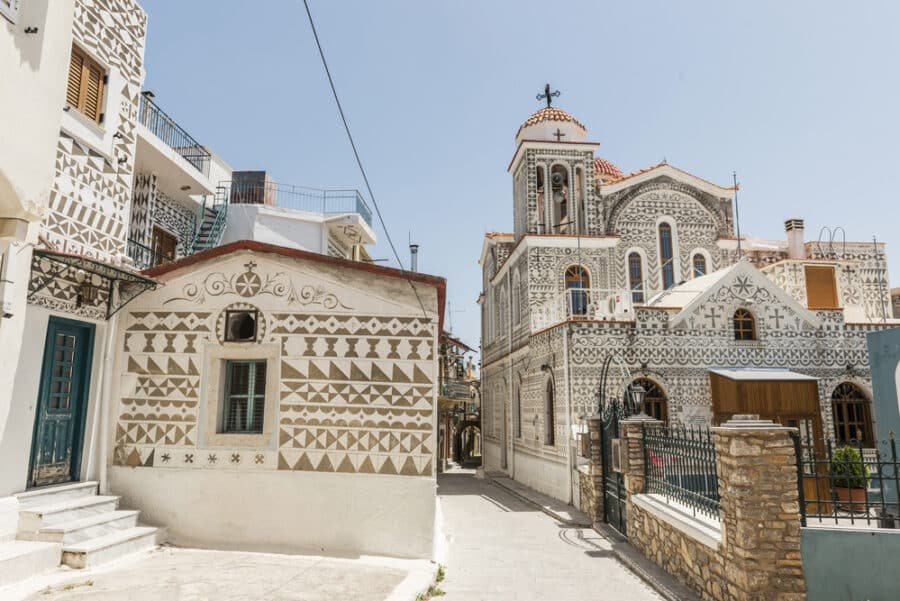
The Monasteries of Daphni, Hosios Loukas, and Nea Moni of Chios are a group of three monasteries located in central Greece. They represent the highest expression of Byzantine religious architecture and art, with impressive frescoes and mosaics. The monasteries are also renowned for their well-preserved interiors, which feature detailed carvings and intricate decorative designs.
These monasteries are an essential destination for anyone interested in the history and culture of Greece.
13. Pythagoreion And Heraion Of Samos
The Pythagoreion and Heraion of Samos are two archaeological sites in the eastern Aegean Sea. They are a reminder of the island’s ancient past, with ruins that date back to the 8th century B.C. Highlights include the remains of fortifications, temples, palaces, and public buildings. The site is also home to a museum, where visitors can learn more about the island’s rich history and culture.
A visit to the Pythagoreion and Heraion of Samos is essential to any Greek history tour.
14. Archaeological Sites Of Mycenae And Tiryns
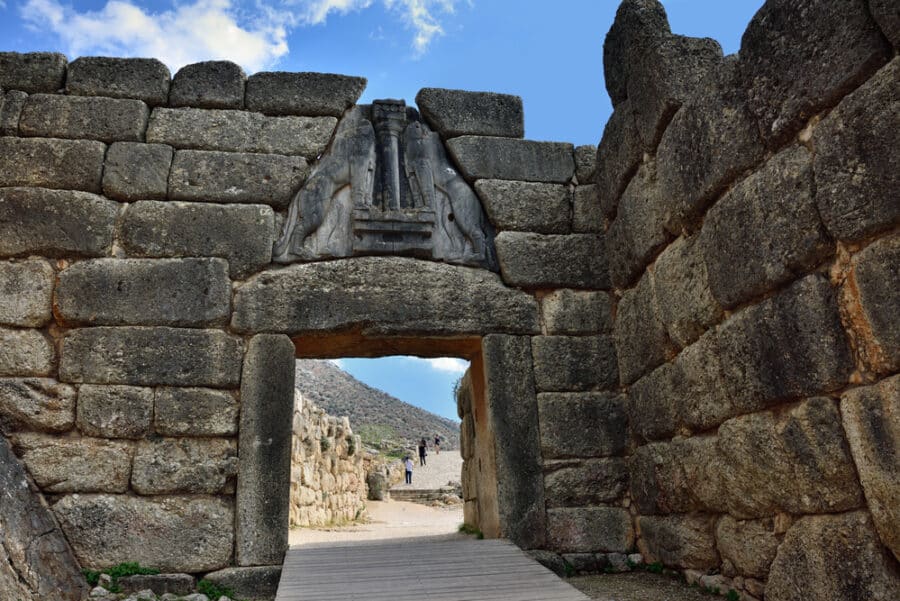
The Archaeological Sites of Mycenae and Tiryns are two of Greece’s most important UNESCO Greece sites. Mycenae was the political center of the Mycenaean Civilization, while Tiryns was its military stronghold. These sites are a must-see for anyone interested in ancient Greek history and culture.
The Archaeological Site of Mycenae is located in the Argolid region of Greece. The site includes the remains of the Mycenaean palace and the Lion Gate, a massive stone gate decorated with two lion sculptures. The Mycenaean civilization was one of the most influential civilizations in the Bronze Age, and its influence can still be seen in Greek culture today.
The Archaeological Site of Tiryns is located in the Argolis in the Peloponnese, Greece. The site includes the remains of the Tiryns palace and the Cyclopean Walls, a massive defensive wall built by humans and thought impossible to construct without the help of giants. The Tiryns civilization was one of the most aggressive civilizations in the Bronze Age, and its influence can still be seen in Greek culture today.
15. Historic Centre (Chorá) With The Monastery Of Saint John

The Historic Centre (Chorá) with the Monastery of Saint John the Theologian and the Cave of the Apocalypse on the island of Patmos is indeed a UNESCO World Heritage site, recognized for its profound historical, cultural, and religious significance. This site encapsulates a unique blend of natural heritage, architectural marvels, and spiritual depth, making it a cornerstone of Christian heritage worldwide.
Here are more details about its components and significance:
Monastery of Saint John the Theologian
- Foundation: the monastery was founded in 1088 by Saint Christodoulos in honor of Saint John the Theologian. This was after receiving the grant of the whole island of Patmos from the Byzantine Emperor Alexios I Komnenos, who ruled from 1081 to 1118, as a refuge for the Saint
- Architecture: the monastery is an exemplary specimen of Byzantine architecture, with its formidable fortifications mirroring the need for defense against pirate raids and invasions throughout the centuries. Its walls enclose chapels, courtyards, monks’ cells, and a richly endowed library
- Library: the library within the monastery is renowned for its vast collection of manuscripts, codices, and religious texts, including important Byzantine texts and documents dating back several centuries. It holds over 3,000 volumes of manuscripts and printed books, making it one of the most valuable collections in the Christian world
Cave of the Apocalypse
- Significance: this sacred cave is believed to be where Saint John received his Revelation, also known as the Apocalypse, around the end of the 1st century A.D. The cave’s interior features inscriptions, icons, and a small chapel, encapsulating its spiritual atmosphere
- Visitation: the site is a major pilgrimage destination, drawing visitors who wish to see the place where the Apocalypse was written. Inside, one can see the crack in the rock which is said to be where Saint John heard the voice of God
Historic Centre (Chorá)
- Chorá: the settlement that surrounds the Monastery of Saint John, known as Chorá, is characterized by its narrow lanes, white-washed houses, and small squares that have retained their medieval character. It provides a living example of a traditional Greek island town, complete with historical and architectural interest
- Cultural Impact: beyond its religious significance, the site has played a crucial role in the dissemination of Greek Orthodox monasticism and spirituality. The monastic ideals and scholarly pursuits conducted here have had a lasting impact on the Eastern Orthodox Church and Christianity as a whole
UNESCO Recognition
- World Heritage Listing: the ensemble of the Monastery of Saint John the Theologian, the Cave of the Apocalypse, and the medieval settlement of Chorá was inscribed on the UNESCO World Heritage list in 1999. This recognition was based on the site’s outstanding universal value as a testament to human spiritual and cultural achievements
16. Mount Athos

Mount Athos is an autonomous region located in northeastern Greece. It was declared a World Heritage Site by UNESCO due to its natural beauty and its rich cultural heritage.
The region is home to 20 monasteries, the oldest of which dates back to the 10th century. Each monastery has a unique history and culture; some are built in the traditional Byzantine style. Mount Athos is a popular destination for pilgrims worldwide and those seeking an escape from the hustle and bustle of everyday life.
Visiting Mount Athos is an unforgettable experience for anyone interested in Greek history and culture.
17. Archaeological Site of Philippi
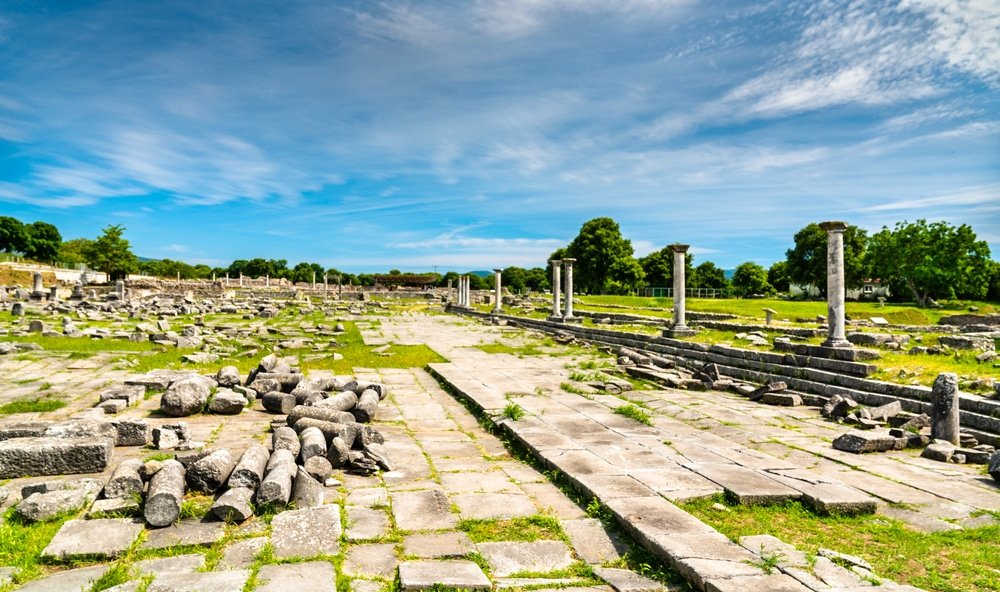
If you are looking for an archaeological site full of Greek history, the Archaeological Site of Philippi is the perfect destination. This UNESCO list site is located in Eastern Macedonia. The site includes the ancient city of Philippi, which Philip II of Macedon founded in 356 BC. The city was an important strategic center during the Hellenistic and Roman periods, and its ruins reflect this rich history.
The Archaeological Site of Philippi is especially notable for its well-preserved defensive walls and theater, one of the largest in the Greek world. Tens of thousands of visitors visit the site each year to learn about its fascinating history and explore its beautiful ruins.
18. Archaeological Site Of Aigai

The Archaeological Site of Aigai (modern Vergina) in northern Greece is a treasure trove of ancient Macedonian history and culture, offering profound insights into the civilization that played a pivotal role in the formation of the Hellenic world and the expansion of its influence under Alexander the Great.
The significance of the ancient city of Aigai as the first capital of the Kingdom of Macedon and its UNESCO World Heritage status is anchored in its rich archaeological finds and historical importance.
Here’s an expanded look into its key features:
Historical Background
- Establishment and Significance: Aigai was established in the 7th century BCE and emerged as the cradle of the Macedonian kingdom. By the 4th century BCE, it had become the most important cultural and political center of the Macedonian kingdom, reflecting the wealth and power of the Argead dynasty, to which Philip II and Alexander the Great belonged
- Cultural and Political Hub: as the ancient capital, Aigai was the site of significant events, including royal weddings, funerals, and major political decisions that shaped the history of Greece and the wider ancient world
Archaeological Discoveries
- Royal Tombs: the discovery of the Royal Tombs, including that of King Philip II, who was assassinated in 336 BCE, marked a significant archaeological milestone. These tombs revealed a wealth of artifacts, including weaponry, ceremonial items, and the famous gold larnax (chest) containing the remains of the king, distinguished by the emblem of the Macedonian star
- Tomb of the Prince (possibly Alexander IV): another tomb, often referred to as the “Prince’s Tomb,” is believed to belong to Alexander IV, the son of Alexander the Great. Like Philip’s tomb, it contained rich grave goods that underscore the wealth and artistry of the Macedonian elite
- Artifacts and Artworks: the site has yielded numerous vital artworks and artifacts, including exquisite frescoes, gold crowns, silver urns, and intricate jewelry, which illustrate the sophistication of Macedonian craftsmanship and artistic expression
UNESCO Recognition
- World Heritage Listing: inscribed on the UNESCO World Heritage list in 1996, the site is recognized for its outstanding historical, cultural, and archaeological value, offering unparalleled insights into the lives of the Macedonian royalty and the society they led.
- Preservation and Study: The designation has helped in the conservation and study of the site, allowing for continued archaeological exploration and a deeper understanding of ancient Macedonian culture and its impact on subsequent historical periods
Visitor Experience
- Museum of the Royal Tombs: the modern museum built over the Royal Tombs allows visitors to experience the archaeological site with minimal intrusion into the landscape. It provides a unique opportunity to view the tombs and artifacts in situ, offering an immersive glimpse into ancient Macedonian life and rituals
Significance
The Archaeological Site of Aigai is not just an essential stop for those interested in Greek history or archaeology; it is a profound link to the past, showcasing the grandeur, political intrigue, and cultural achievements of ancient Macedonia. The discoveries made at Vergina have dramatically enriched our understanding of Macedonian kingship, burial practices, and artistic accomplishments, bridging millennia through tangible links to a time when Macedonia stood at the forefront of the ancient world.
19. Zagori Cultural Landscape (Added In 2023)
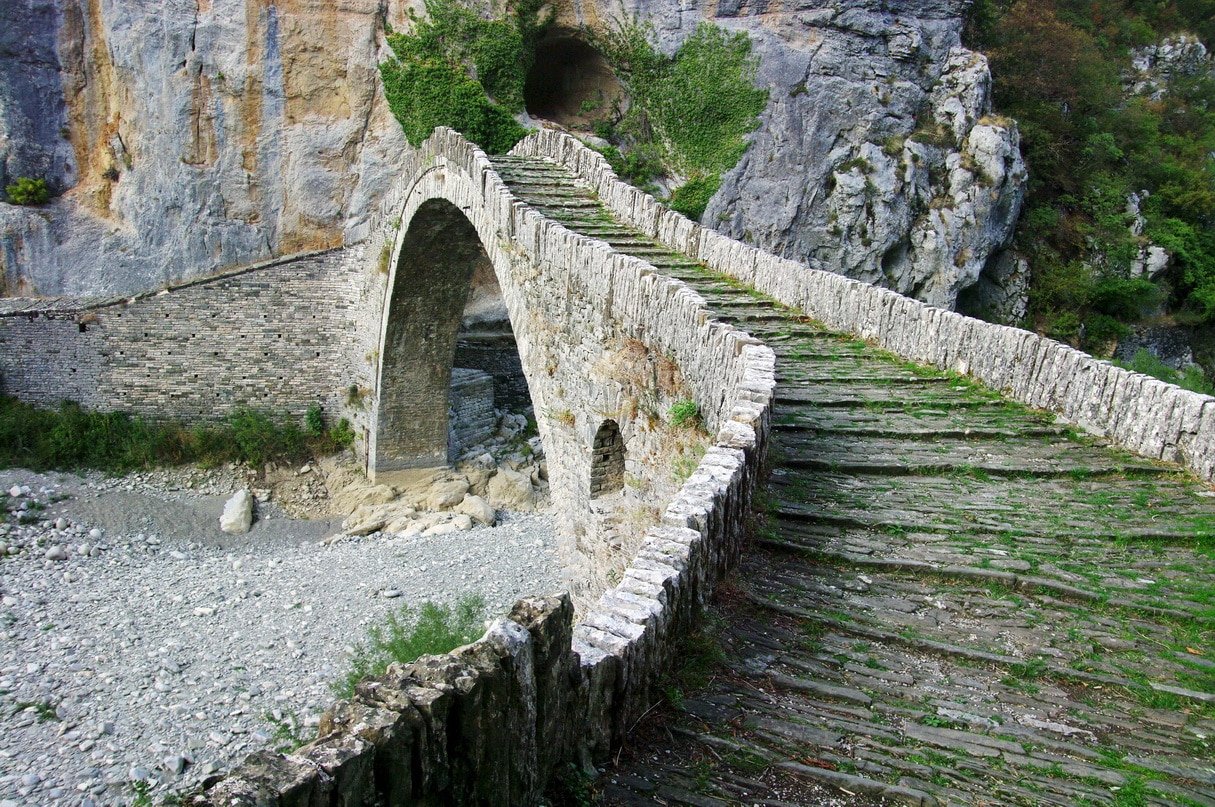
The Zagori Cultural Landscape, nestled in the heart of Epirus, Greece, stands as a testament to the harmonious relationship between human beings and nature. Inscribed as a UNESCO World Heritage Site in 2023, this breathtaking region is celebrated not only for its pristine natural beauty but also for its rich cultural heritage that spans centuries. Zagori is a unique area that boasts a distinctive architectural style, with its stone-built villages, arched bridges, and monasteries blending seamlessly into the rugged mountainous terrain of the Pindus range.
This cultural landscape is defined by its deep, verdant gorges, crystal-clear rivers, and dense forests, offering an unparalleled experience of Greece’s wilderness. The region’s traditional stone masonry is evident in its well-preserved dwellings, public buildings, and paths, which have been maintained through the ages, showcasing the area’s resilience and the locals’ deep respect for their environment.
Zagori’s addition to the UNESCO list highlights its global significance as an area where the interaction between humans and their environment has created a landscape of exceptional beauty and cultural importance. The recognition serves not only to preserve the region’s natural and architectural wonders but also to promote sustainable tourism practices that respect and protect its heritage.
Visitors to Zagori are invited to explore its network of hiking trails that crisscross the area, leading to secluded monasteries, picturesque villages, and breathtaking viewpoints. The region’s rich biodiversity, including its flora and fauna, further enhances its appeal as a destination for nature lovers and cultural enthusiasts alike. With its inscription in 2023, the Zagori Cultural Landscape proudly takes its place among the world’s protected areas, ensuring its preservation for future generations while inviting the world to discover its timeless beauty and cultural depth.
Move This Adventure To Your Inbox & Get An Instant Freebie

No spam. Unsubscribe at any time.
List Of World Heritage Sites In Greece On The Tentative List
Ancient Lavrion
Lavrion was one of the most important ancient centers of silver mining and has a history that stretches back to the prehistoric period.
Mount Athos (Extended Property)
Inscribed initially as a mixed cultural and natural site, Greece has proposed an extension to include additional areas or attributes.
Extensions Of The “Delos” property
Delos, a sacred island in ancient Greek mythology, is proposed to have its designated area extended.
The Ancient Olive Groves Of The Mediterranean
This proposal aims to recognize the cultural and historical significance of ancient olive groves across the Mediterranean region, including those in Greece.
The Philippi Area
The archaeological site of Philippi, which includes the ruins of a Roman city that was important in early Christian history, is proposed for further recognition or extension.
The Archaeological Site Of Nikopolis
Caesar Augustus founded Nikopolis in commemoration of his victory over Antony and Cleopatra at Actium. It’s an important cultural site reflecting Roman and Greek influences.
Late Medieval Bastioned Fortifications In Greece
This proposal would recognize the extensive network of late medieval fortifications built by various powers in Greece, showcasing advancements in military architecture.
The Spinalonga Fortress
Located on the island of Spinalonga, this fortress has a rich history ranging from Venetian occupation to a leper colony in the 20th century.
The Monasteries Of Daphni, Hosios Loukas, And Nea Moni Of Chios (extension)
These Byzantine monasteries, already recognized for their significant mosaics and architecture, may have proposed extensions to their recognized areas.
The Dodecanese
A proposal might include the historical and archaeological significance of this group of islands, reflecting various periods from ancient Greece to medieval times.
The Minoan Palatial Centres (Knossos, Phaistos, Malia, Zakros, Kydonia)
Proposals for these sites would emphasize the significance of the Minoan civilization and its architectural, artistic, and technological achievements.
World Heritage Site FAQs
How many UNESCO World Heritage Sites are there in Greece?
There are 19 UNESCO World Heritage Sites in Greece. The latest was added in 2023.
Why is Aigai important?
Aigai was the former capital of the ancient Kingdom of Macedon.
Which site served as the spiritual center of ancient Greece?
Delphi served as the spiritual center of the ancient Greek world.
Where were the ancient Olympic Games held?
The birthplace of the Olympic Games was held in ancient Olympia.
What is significant about Mystras and Rhodes?
Mystras signifies the final years of the Byzantine Empire, while Rhodes houses structures from the Ottoman period and the rule of the Order of St. John.
What’s special about the monasteries Daphni, Hosios Loukas, and Nea Moni of Chios?
These monasteries are highlighted for their significance in the “second golden age of Byzantine art.”
What is the importance of the Old Town of Corfu and Mount Athos?
The Old Town of Corfu is noted for its strategic position and preserved state. Mount Athos has been known as a spiritual center since the mid-11th century.
What heritage sites showcase Greek architecture?
The Pythagoreion and Heraion of Samos and the Temple of Apollo Epicurius at Bassae showcase Greek architecture.
Which is the latest site to be incorporated into the UNESCO World Heritage Site list?
Philippi, known as “Small Rome,” is the latest site to be incorporated.
Final Word On Unesco Sites In Greece
So, as you can see, Greece is home to some of the world’s most impressive and vital UNESCO World Heritage Sites. From ancient ruins to breathtaking monasteries, these sites are essential destinations for anyone interested in Greek history and culture. Whether you’re a history buff or simply looking for a unique experience, there’s something for everyone in Greece. So pack your bags and get ready to explore one of the world’s most fascinating countries!
- Unique Things To Do In Greece With Kids
- How To Tip In Greece
- Car Rental And Driving Tips For Greece
- Where To Stay In Crete
- What To Expect & Do In September In Greece
- Things To Do In Greece During The Winter
- Packing Tips For Greece
- Things To Do And Eat During Easter In Greece
- How To Travel Greece On A Budget
- How To Get From Santorini To Crete
- Things To Do In Corfu For Families
- Best Cave Hotels In Greece
- Where To Stay On Corfu
- Greek Island Groups – Everything You Need To Know
- Mainland Beaches In Greece Not To Miss

